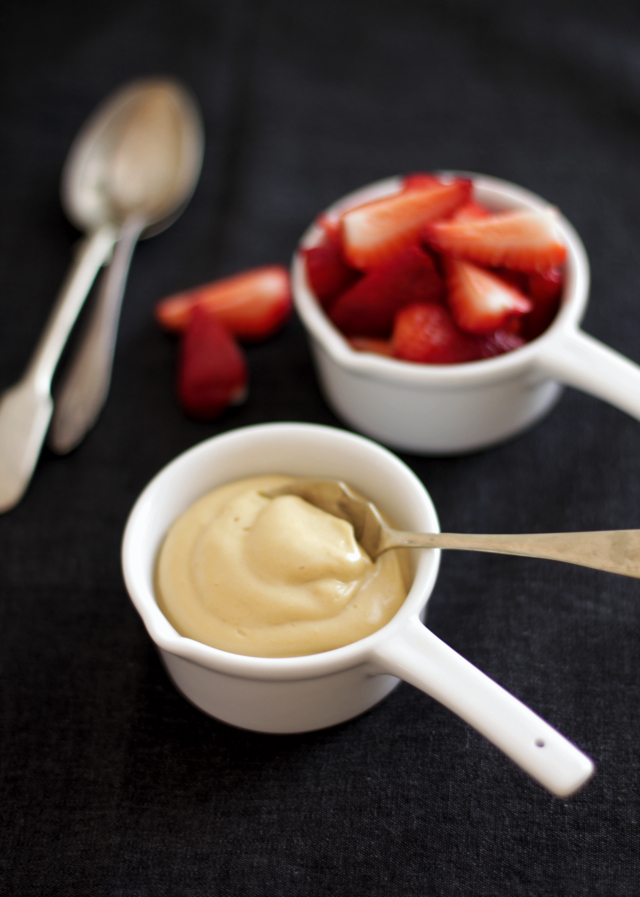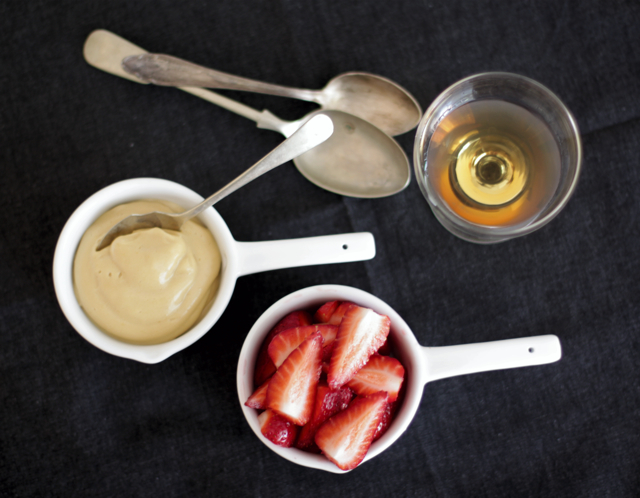Around this time of the year in Australia, it’s only natural to make pavlova for every summer party. It’s the quintessential Australian dessert, with a crispy-on-the-outside-fluffy-on-the-inside meringue, freshly whipped cream and seasonal fruit. But then you’re left with all those egg yolks, which I hate to waste. So I’ve found the best thing for those orphan egg yolks: zabaione.

In fact, this old fashioned Italian dessert – a more adult version of innocent custard – should be on every cook’s repertoire.
It’s so good and so quick that I’m now finding I’m having to make pavlovas to use up all the excess egg whites that end up in my fridge after more requests for zabaione from my husband. (Incidentally, I’ve discovered zabaione is also amazing drizzled over pavlova in place of the whipped cream. Add some stewed or fresh, slightly tart nectarines to offset the sweetness and you have a slightly richer, more decadent, variation on the regular old pavlova and – no left over egg whites or yolks).
Literally whipped up in just a few minutes, it has a gorgeous, rich, creamy and silky texture that makes it a more decadent alternative to pouring custard or softly whipped cream for any of your favourite desserts. Imagine a boozy zabaione on a warm pear crumble or perhaps accompanying a simple chocolate tart. I recently made it to go over pancakes. Or for a more traditional end to a meal, serve it in small glasses with strawberries or almond biscotti. It even makes a wonderful base for ice-cream – the possibilities are literally endless.

Often known by its French translation, sabayon, this Italian recipe has been commonly used in northern and central Italy for centuries. There are versions of zabaione in the famous Renaissance chef Bartolomeo Scappi’s Opera of 1570 where Muscat and cinnamon mixed with egg yolks were flavoured with chicken broth (Renaissance tastes favoured mixing sweet and savoury, like in this Renaissance biancomangiare recipe). A century later in Latini’s 1694 cookbook the zabaione was just sweet and also contained pistachio.
The following recipe, based on Artusi’s 1891 cookbook is, naturally, the Tuscan version, made with the sweet local wine, vin santo. If you can’t get this, Marsala or moscato or any other sweet wine can also be used. Adding a shot of rum or brandy doesn’t hurt either. For a non-alcoholic version, substitute the vin santo with a shot of hot, fresh espresso – this is the way my husband’s grandmother used to prepare it for him when he was little before sending him off to soccer practice! She wouldn’t even need to use the saucepan, she would just add a boiling hot shot of espresso to the egg and sugar and whisk away, with the heat from the coffee cooking the mixture.
Try it and you’ll see why this delicious dessert has a reputation for giving you a boost of energy.

Per person:
- 1 egg yolk
- 10 grams of fine white sugar
- 50 ml of vin santo
- a splash of rum or brandy, optional
Whisk the yolks and sugar together in a heat-proof bowl until the mixture becomes pale and creamy. Add the vin santo and, if using, the shot of rum or brandy. Continue whisking with the bowl over a double broiler or bain marie for a few minutes (do not allow the water to touch the bottom of the pan so try to use a saucepan that is smaller than the bowl), until the mixture thickens. Take it off the heat just when you think it is almost ready – like many egg dishes, this is a delicate dish and will continue to cook a little even after you take it off the heat. If you like, some cinnamon can be added.
Serve warm alone, with biscotti, some fruit or instead of cream or custard on your favourite desserts.




Comments
do you know san baylon? http://www.divinacucina-blog.com/2007/05/zab-baylon.html
That’s fantastic! My kind of story 🙂 I’d only known of San Lorenzo being the patron saint of cooks (you know, the whole grill thing!).
That is something so delicious! Perfect when made with vin santo.
Cheers,
Rosa
Zabaione is such a delicious (and easy) summer treat and I really enjoyed learning more about it here.
Delicious, thank you so much for sharing!
I haven’t tried pavlova yet, not even once, can you believe it?! I am so disappointed, I will have to make it myself soon. But I did try zabaione multiple times, especially living in Piedmont, and of course I love it, especially served with torta di nocciole (like the one you made :D). yum!
Valeria, I can’t believe you’ve never had pavlova! What are you waiting for? 🙂 I never tried it when I’ve been there but I’m sure the zabaione in Piedmont (and ooh, with torta di nocciole) must be amazing (dare I say better than the Tuscan version?!).
I’ve made pavlovas, but never zabaione. This is definitely on my must-try list this month (despite summer being a few months away here in the states).
Zabaione is also great in the cold weather, still warm and fresh off the stove! 😉
Yummm! I always thought zabaione was more of a drink than a custard, the Italian egg nog really. But I like the idea of a custard way more! I love that creamy, smooth consistency… ugh, wish I had some right now, come think of it…
Hi, well I have to admit, I like it thick and custard-like, but Marco (my husband) happily has his zabaione more like a thick drink and drinks it out of in an espresso cup! The good thing is it’s easy to go either way!
after i make meringues at home, we’re eating carbonara and custards and zabaione. this recipe looks divine!